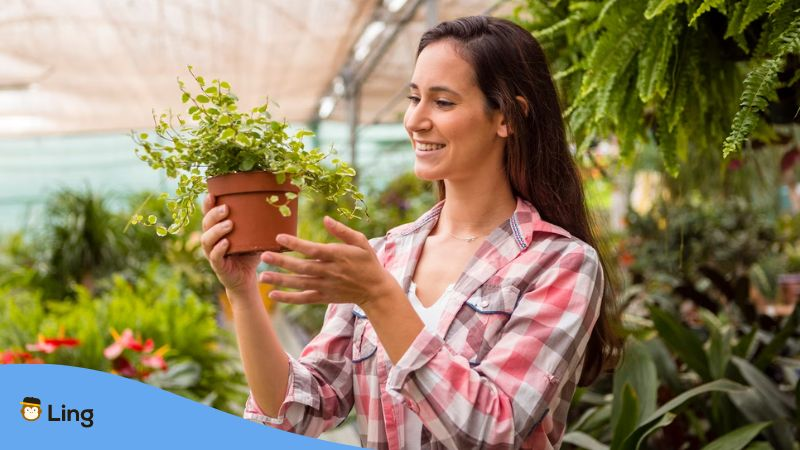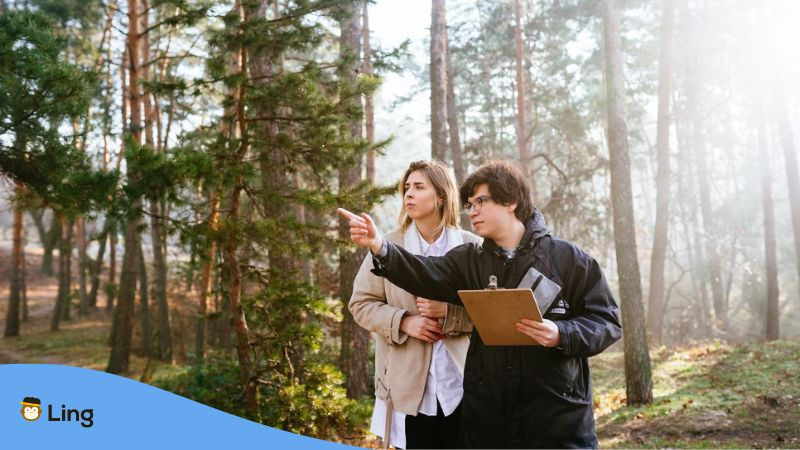Lithuania’s rich and diverse flora is a tapestry of colors, shapes, and functions. But understanding the plants in Lithuanian, the country’s native language, adds a whole new dimension to their beauty. From towering pine trees to delicate wildflowers, learning the names and cultural significance of these plants in Lithuania connects you to the land in a unique way.
Whether you’re a nature lover, a gardener, or simply curious about the Lithuanian language, this article has something for you. Let’s begin.
Native Trees And Shrubs
In Lithuania, native trees and shrubs are essential to the landscape. They provide homes for animals and are used in various ways by people.
Here’s a closer look at three significant ones.
The Symbolic European Birch (Beržas)
The European Birch, known as Beržas in Lithuanian, is a common tree in the country. Its white bark and slender trunk make it easy to recognize.
In Lithuania, it’s a symbol of purity and renewal. People use its wood for making furniture. And in spring, they tap the sap to make a traditional drink.
Scots Pine: Pinus Sylvestris (Pušis)
The Scots Pine, or Pušis, is another well-known tree in Lithuania. It grows tall and straight, often in sandy soils.
This tree is essential for the forest ecosystem, providing shelter for many animals. Its wood is strong and is used in construction and woodworking.
Common Hazel: A Nut-Bearing Shrub (Lazdynas)
The Common Hazel, called Lazdynas in Lithuanian, is a shrub that produces edible nuts.
These nuts are harvested in autumn and are a popular ingredient in Lithuanian dishes. The hazel’s branches are also used in traditional crafts, like weaving.

Wildflowers And Herbs
Lithuania’s landscapes are not just about trees and shrubs. You’ll also find a variety of wildflowers and herbs.
These plants add color to the scenery and have many uses, from medicine to Lithuanian foods. Let’s explore some of them.
Heather (Calluna Vulgaris): The Moorland Beauty
Heather, or Vytis, is a common sight in the moorlands of Lithuania. Its purple flowers bloom in late summer, creating a beautiful carpet across the land. But Heather is not just pretty to look at. It’s also used in traditional medicine for treating various ailments.
Edible Wild Plants: From Berries To Nettles
Lithuania’s wild plants are not just for show. Many of them are edible. For example, wild strawberries (Žemuogės) are a sweet treat you can find in the forests.
Nettles (Dilgėlės), though they sting, are used in Lithuanian cooking. These wild plants are a link to Lithuania’s culinary traditions.
Weeds And Invasive Species
Not all plants in Lithuania are welcome. Some, like the invasive Himalayan Balsam (Himalajų Balzaminas), can cause problems. These plants grow quickly and can take over an area, pushing out native plants. Controlling these weeds and invasive species is a big job in Lithuania.
Gardens And Cultivated Plants
Gardening is a cherished tradition in Lithuania. From growing food to creating beautiful spaces, gardens are a big part of Lithuanian life.
Let’s take a closer look at what makes Lithuanian gardens special.
Traditional Lithuanian Gardens
In Lithuania, traditional gardens are more than just a place to grow food. They’re a connection to the land and the seasons. No wonder why many of the locals say that they prefer growing vegetables like potatoes (Bulvės), carrots (Morkos), and herbs like dill (Krapai) in their gardens at home. These gardens are often family projects, with everyone helping out.
Cultivating Edible Plants
Growing food is vital in Lithuania. Many families have gardens where they grow their own vegetables and Lithuanian fruits. You’ll find apple trees (Obelų medžiai), berry bushes like currants (Sergėtojai), and many other edible plants. These gardens provide fresh, healthy food and are a source of pride for many Lithuanians.
Ornamental Flowers And Plants
But plants in Lithuanian gardens are not just about food. People also grow beautiful flowers and ornamental plants. You might see roses (Rožės), tulips (Tulipės), and lilies (Lelijos) in a Lithuanian garden. These plants add color and beauty, and many people take great care in arranging them.

Seasonal Changes And Plant Life
In Lithuania, the four distinct seasons have a big impact on plants. Each season brings its own changes and challenges.
Let’s see how the seasons shape the growth and appearance of plants in Lithuania.
Early Spring Blooms
Spring in Lithuania is a time of renewal. As the snow melts, plants start to wake up. You’ll see crocuses (Krokai) and daffodils (Narcizai) blooming. Trees like the birch (Beržas) begin to bud. It’s a time of fresh starts and new growth.
Summer’s Lush Growth
Summer is a busy time for plants in Lithuania. The days are long, and there’s plenty of sun. During this time, trees like the Scots Pine (Pušis) grow taller, and wildflowers like Heather (Vytis) bloom. Gardens are full of vegetables and fruits, like strawberries (Žemuogės) and apples (Obuoliai).
Autumn Colors And Harvest
Autumn is a time of change in Lithuania. Leaves on trees like the oak (Ąžuolas) turn beautiful colors. It’s also harvest time. At this time of the year, people often spend most of their time picking apples, berries, and vegetables from their gardens. It’s a time to enjoy the rewards of the growing season, after all!
Winter Dormancy And Survival
Winter in Lithuania is a time of rest for plants. Many trees and plants go dormant. But they’re not dead; they’re just sleeping. Some plants, like the pine (Pušis), stay green all winter. Others, like the hazel (Lazdynas), lose their leaves but will bloom again in the spring.
Conservation And Sustainability
In Lithuania, taking care of the environment is essential. Efforts are made to conserve native species and promote sustainable practices. Here’s how:
- Protecting Endangered Species: Lithuania has laws to protect plants that are in danger. Some plants, like certain orchids (Orchidėjos), are protected. This means you can’t pick them up or disturb their habitats.
- Sustainable Gardening Practices: Many Lithuanians practice sustainable gardening. They use natural methods to take care of pests and diseases. They also use water wisely and compost to recycle plant waste.
- Lithuania’s Role in Global Biodiversity: Lithuania’s plants are part of the world’s biodiversity. The country works with other nations to protect plants and share knowledge. This helps keep the world’s plants healthy and diverse.
Learn The Plants In Lithuanian With Ling!
Interested in plants and want to learn their names in Lithuanian? The Ling app is your perfect companion.
And it’s not just Lithuanian. The Ling app offers lessons in 60+ languages. Whether you’re planning a trip to Lithuania or simply fascinated by its flora, Ling makes learning easy and enjoyable.
Download the Ling app on Google Play and the App Store. Start your journey with plants in Lithuanian today!






























































